CHAPTER 13: DECADES OF CHANGE: 1960-1980
then began the process of dereg-
But Carter enjoyed less success
ulation, the removal of govern- with the Soviet Union . Though he
mental controls in economic life . assumed office with détente at high
Arguing that some restrictions over tide and declared that the United
the course of the past century lim- States had escaped its “inordinate
ited competition and increased con- fear of Communism,” his insistence
sumer costs, he favored decontrol in that “our commitment to human
the oil, airline, railroad, and truck- rights must be absolute” antagonized
ing industries .
the Soviet government . A SALT II
Carter’s political efforts failed to agreement further limiting nuclear
gain either public or congressional stockpiles was signed, but not rati-
support . By the end of his term, his fied by the U .S . Senate, many of
disapproval rating reached 77 per- whose members felt the treaty was
cent, and Americans began to look unbalanced . The 1979 Soviet inva-
toward the Republican Party again . sion of Afghanistan killed the treaty
Carter’s greatest foreign policy and triggered a Carter defense build-
accomplishment was the negotiation up that paved the way for the huge
of a peace settlement between Egypt, expenditures of the 1980s .
under President Anwar al-Sadat, and
Carter’s most serious foreign pol-
Israel, under Prime Minister Men- icy challenge came in Iran . After an
achem Begin . Acting as both medi- Islamic fundamentalist revolution
ator and participant, he persuaded led by Shiite Muslim leader Ayatol-
the two leaders to end a 30-year state lah Ruhollah Khomeini replaced a
of war . The subsequent peace treaty corrupt but friendly regime, Carter
was signed at the White House in admitted the deposed shah to the
March 1979 .
United States for medical treatment .
After protracted and often emo- Angry Iranian militants, supported
tional debate, Carter also secured by the Islamic regime, seized the
Senate ratification of treaties ced- American embassy in Tehran and
ing the Panama Canal to Panama by held 53 American hostages for more
the year 2000 . Going a step farther than a year . The long-running hos-
than Nixon, he extended formal dip- tage crisis dominated the final year
lomatic recognition to the People’s of his presidency and greatly dam-
Republic of China .
aged his chances for re-election . 9
292

The digital revolution of the past decade has transformed
the economy and the way Americans live, influencing work;
interactions with colleagues, family, and friends; access to
information; even shopping and leisure-time habits.
21ST CENTUR
N A T I O N
Y
A P I C T U R E P R O F I L E
The first years of the new century unleashed a new threat to
peace and democracy: international terrorist attacks that killed and
maimed thousands in the United States and around the world.
Just as it has with earlier dangers, the United States took up this
formidable challenge in unison with its allies. At the same time,
it coped with changes sparked by globalization, fast-paced
technological developments, and new waves of immigration that
have made American society more diverse than in the past.
The country sought to build upon the achievements of its history,
and to honor those who have sacrificed for its cause.
293
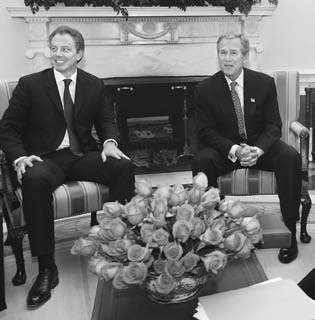

Malalai Joya, one of
about 100 women
delegates to the
constitutional council
in Afghanistan, speaks
to the council in Kabul,
December 17, 2003.
Afghanistan has its first
democratically elected
government as a result
of the U.S., allied, and
Northern Alliance
military action in 2001
that toppled the Taliban
for sheltering Osama bin
Laden, mastermind of
the September 11, 2001,
terrorist attacks against
the United States.
294
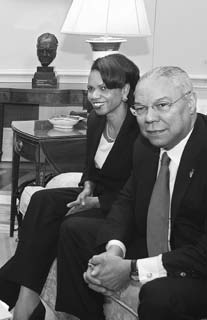
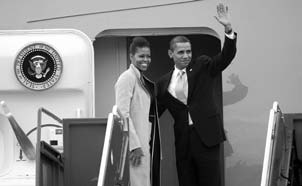
President George W. Bush
(center) meets with British
Prime Minister Tony Blair
(left), National Security
Adviser Condoleezza Rice,
and Secretary of State Colin
Powell (right) at the White
House during his first term.
Great Britain has been a key
U.S. ally in the fight against
terrorism.
President Barack Obama and first lady Michelle Obama wave goodbye from
Gardermoen Airport outside Oslo, Norway. President Obama was in Oslo to
receive the Nobel Peace Prize on December 10, 2009.
295
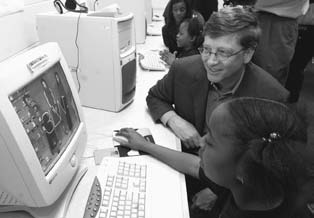

Top, Microsoft chairman Bill Gates talks with Antwoinette Hayes, a participant in a Microsoft initiative to provide technology access to children and teens.
Above, Apple founder and chief executive officer Steve Jobs with his
company’s iPod mini. Gates and Jobs are seen as the most powerful symbols of
the creative and commercial talent that shaped the digital era.
296

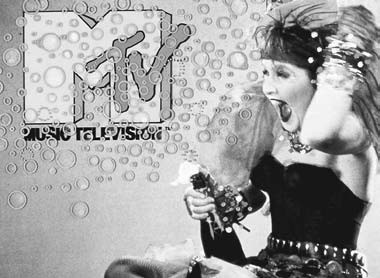
Cable News Network (CNN) report from Moscow: The combination of hundreds
of cable television channels and 24-hour news services like CNN gives an
unprecedented impact and immediacy to news developments around the world.
Combine youth, rock and hip hop music, and 24-hour television, and you get MTV, a television network whose influence extends beyond music videos to fashion,
advertising, and sales.
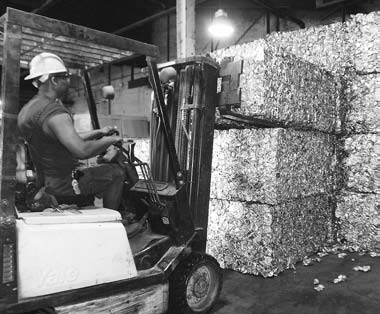
Bales of sorted recyclables are stacked for processing
at the Rumpke recycling center in Columbus, Ohio.
Growing environmental consciousness in the United
States has led to huge recycling efforts for materials
such as glass, paper, steel, and aluminum.
298


The massive AIDS quilt, with each square commemorating an individual who
has died of the disease. The United States is a leading contributor to the
fight against this global pandemic.
299

Americans’ love affair with the automobile continues, resulting
in increased traffic congestion as well as considerable efforts by
government and industry to reduce air pollution.
300


Iraqis queuing to vote for a Transitional National Assembly at a polling station in the center of Az Zubayr, Iraq, January 30, 2005. More than 8.5 million Iraqis braved threats of violence and terrorist attacks to participate in the elections. The vote followed the 2003 war, led by the United States and other coalition members, which rid Iraq of dictator Saddam Hussein.
302

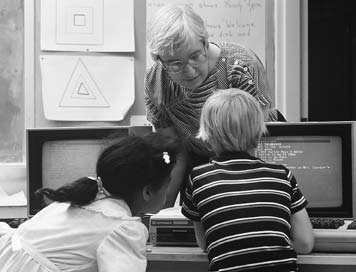
With husbands and wives in the typical family both working outside the home,
daycare centers for children are commonplace throughout the United States.
A new generation peers into its future.
303
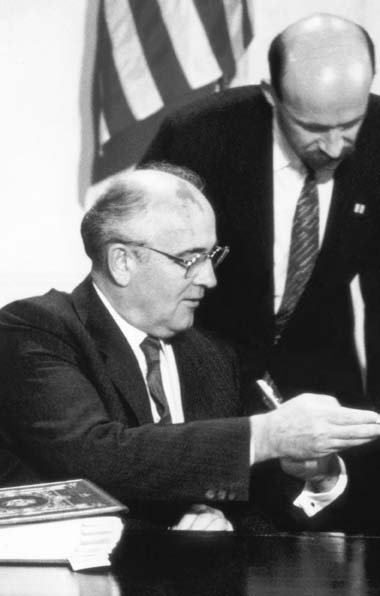
304
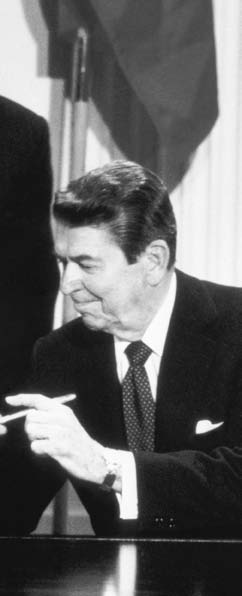
C H A P T E R
14THE
NEW
CONSERVATISM
AND
A
NEW
WORLD
ORDER
President Ronald Reagan
and USSR President
Mikhail Gorbachev after
signing the Intermediate–
Range Nuclear Forces
(INF) Treaty, December
1987.
CHAPTER 14: THE NEW CONSERVATISM AND A NEW WORLD ORDER
“I have always believed that
there was some divine plan
that placed this great continent
between two oceans to be sought
out by those who were possessed
of an abiding love of freedom
and a special kind of courage.”
California Governor Ronald Reagan, 1974
A SOCIETY IN TRANSITION
software that could aggregate previ-
S
ously unimagined amounts of data
hifts in the structure of Ameri- about economic and social trends .
can society, begun years or even de- The federal government had made
cades earlier, had become apparent significant investments in computer
by the time the 1980s arrived . The technology in the 1950s and 1960s
composition of the population and for its military and space programs .
the most important jobs and skills
In 1976, two young California en-
in American society had undergone trepreneurs, working out of a garage,
major changes .
assembled the first widely marketed
The dominance of service jobs in computer for home use, named it
the economy became undeniable . By the Apple, and ignited a revolution .
the mid-1980s, nearly three-fourths By the early 1980s, millions of mi-
of all employees worked in the ser- crocomputers had found their way
vice sector, for instance, as retail into U .S . businesses and homes, and
clerks, office workers, teachers, phy- in 1982, Time magazine dubbed the sicians, and government employees . computer its “Machine of the Year .”
Service-sector activity benefited
Meanwhile, America’s “smoke-
from the availability and increased stack industries” were in decline .
use of the computer . The informa- The U .S . automobile industry reeled
tion age arrived, with hardware and under competition from highly ef-
306
OUTLINE OF U.S. HISTORY
ficient Japanese carmakers . By 1980 1980, 808,000 immigrants arrived,
Japanese companies already manu- the highest number in 60 years, as the
factured a fifth of the vehicles sold country once more became a haven
in the United States . American for people from around the world .
manufacturers struggled with some
Additional groups became active
success to match the cost efficien- participants in the struggle for equal
cies and engineering standards of opportunity . Homosexuals, using
their Japanese rivals, but their for- the tactics and rhetoric of the civil
mer dominance of the domestic car rights movement, depicted them-
market was gone forever . The gi- selves as an oppressed group seeking
ant old-line steel companies shrank recognition of basic rights . In 1975,
to relative insignificance as foreign the U .S . Civil Service Commission
steel makers adopted new technolo- lifted its ban on employment of ho-
gies more readily .
mosexuals . Many states enacted an-
Consumers were the beneficiaries ti-discrimination laws .
of this ferocious competition in the
Then, in 1981, came the discov-
manufacturing industries, but the ery of AIDS (Acquired Immune
painful struggle to cut costs meant Deficiency Syndrome) . Transmitted
the permanent loss of hundreds of sexually or through blood transfu-
thousands of blue-collar jobs . Those sions, it struck homosexual men and
who could made the switch to the intravenous drug users with par-
service sector; others became unfor- ticular virulence, although the gen-
tunate statistics .
eral population proved vulnerable as
Population patterns shifted as wel . By 1992, over 220,000 Ameri-
well . After the end of the postwar cans had died of AIDS . The AIDS ep-
“baby boom” (1946 to 1964), the idemic has by no means been limited
overall rate of population growth to the United States, and the effort
declined and the population grew to treat the disease now encompasses
older . Household composition also physicians and medical researchers
changed . In 1980 the percentage of throughout the world .
family households dropped; a quar-
ter of all groups were now classi-
CONSERVATISM AND THE
fied as “nonfamily households,” in
RISE OF RONALD REAGAN
which two or more unrelated per-
sons lived together .
For many Americans, the eco-
New immigrants changed the nomic, social, and political trends of
character of American society in the previous two decades — crime
other ways . The 1965 reform in im- and racial polarization in many ur-
migration policy shifted the focus ban centers, challenges to traditional
away from Western Europe, facilitat- values, the economic downturn and
ing a dramatic increase in new arriv- inflation of the Carter years — en-
als from Asia and Latin America . In gendered a mood of disillusionment .
307
CHAPTER 14: THE NEW CONSERVATISM AND A NEW WORLD ORDER
It also strengthened a renewed sus- gelicals, most of whom regarded
picion of government and its ability abortion under virtually any cir-
to deal effectively with the country’s cumstances as tantamount to mur-
social and political problems .
der . Pro-choice and pro-life (that is,
Conservatives, long out of power pro- and anti-abortion rights) dem-
at the national level, were well po- onstrations became a fixture of the
sitioned politically in the context of political landscape .
this new mood . Many Americans
Within the Republican Party, the
were receptive to their message of conservative wing grew dominant
limited government, strong national once again . They had briefly seized
defense, and the protection of tradi- control of the Republican Party in
tional values .
1964 with its presidential candidate,
This conservative upsurge had Barry Goldwater, then faded from
many sources . A large group of fun- the spotlight . By 1980, however, with
damentalist Christians were partic- the apparent failure of liberalism un-
ularly concerned about crime and der Carter, a “New Right” was poised
sexual immorality . They hoped to to return to dominance .
return religion or the moral precepts
Using modern direct mail tech-
often associated with it to a central niques as well as the power of mass
place in American life . One of the communications to spread their
most politically effective groups in message and raise funds, drawing on
the early 1980s, the Moral Majority, the ideas of conservatives like econ-
was led by a Baptist minister, Jerry omist Milton Friedman, journalists
Falwel . Another, led by the Reverend William F . Buckley and George Will,
Pat Robertson, built an organization, and research institutions like the
the Christian Coalition, that by the Heritage Foundation, the New Right
1990s was a significant force in the played a significant role in defining
Republican Party . Using television to the issues of the 1980s .
spread their messages, Falwell, Rob-
The “Old” Goldwater Right had
ertson, and others like them devel- favored strict limits on government
oped substantial followings .
intervention in the economy . This
Another galvanizing issue for tendency was reinforced by a signifi-
conservatives was divisive and emo- cant group of “New Right” “liber-
tional: abortion . Opposition to the tarian conservatives” who distrusted
1973 Supreme Court decision, Roe v. government in general and opposed Wade, which upheld a woman’s right state interference in personal behav-to an abortion in the early months of ior . But the New Right also encom-
pregnancy, brought together a wide passed a stronger, often evangelical
array of organizations and individ- faction determined to wield state
uals . They included, but were not power to encourage its views . The
limited to, Catholics, political con- New Right favored tough measures
servatives, and religious evan- against crime, a strong national de-
308
OUTLINE OF U.S. HISTORY
fense, a constitutional amendment program of deregulation begun by
to permit prayer in public schools, Jimmy Carter . He sought to abol-
and opposition to abortion .
ish many regulations affecting the
The figure that drew all these consumer, the workplace, and the
disparate strands together was Ron- environment . These, he argued, were
ald Reagan . Reagan, born in Illi- inefficient, expensive, and detrimen-
nois, achieved stardom as an actor tal to economic growth .
in Hollywood movies and television
Reagan also reflected the belief
before turning to politics . He first held by many conservatives that the
achieved political prominence with a law should be strictly applied against
nationwide televised speech in 1964 violators . Shortly after becoming
in support of Barry Goldwater . In president, he faced a nationwide
1966 Reagan won the governorship strike by U .S . air transportation
of California and served until 1975 . controllers . Although the job action
He narrowly missed winning the Re- was forbidden by law, such strikes
publican nomination for president in had been widely tolerated in the past .
1976 before succeeding in 1980 and When the air controllers refused to
going on to win the presidency from return to work, he ordered them all
the incumbent, Jimmy Carter .
fired . Over the next few years the
President Reagan’s unflagging system was rebuilt with new hires .
optimism and his ability to celebrate
the achievements and aspirations THE ECONOMY IN THE 1980s
of the American people persisted
throughout his two terms in office . President Reagan’s domestic pro-
He was a figure of reassurance and gram was rooted in his belief that the
stability for many Americans . Whol- nation would prosper if the power of
ly at ease before the microphone and the private economic sector was un-
the television camera, Reagan was leashed . The guiding theory behind
called the “Great Communicator .”
it, “supply side” economics, held
Taking a phrase from the 17th- that a greater supply of goods and
century Puritan John Winthrop, he services, made possible by measures
told the nation that the United States to increase business investment,
was a “shining city on a hill,” invest- was the swiftest road to economic
ed with a God-given mission to de- growth . Accordingly, the Reagan
fend the world against the spread of administration argued that a large
Communist totalitarianism .
tax cut would increase capital in-
Reagan believed that government vestment and corporate earnings,
intruded too deeply into American so that even lower taxes on these
life . He wanted to cut programs larger earnings would increase gov-
he contended the country did not ernment revenues .
need, and to eliminate “waste, fraud,
Despite only a slim Republican
and abuse .” Reagan accelerated the majority in the Senate and a House
309
CHAPTER 14: THE NEW CONSERVATISM AND A NEW WORLD ORDER
of Representatives controlled by the rise in oil prices pushed up costs,
Democrats, President Reagan suc- and a worldwide economic slump in
ceeded during his first year in office 1980 reduced the demand for agri-
in enacting the major components cultural products . Their numbers
of his economic program, including declined, as production increasingly
a 25-percent tax cut for individu- became concentrated in large opera-
als to be phased in over three years . tions . Those small farmers who sur-
The administration also sought and vived had major difficulties making
won significant increases in defense ends meet .
spending to modernize the nation’s
The increased military budget —
military and counter what it felt was combined with the tax cuts and the
a continual and growing threat from growth in government health spend-
the Soviet Union .
ing — resulted in the federal gov-
Under Paul Volcker, the Federal ernment spending far more than it
Reserve’s draconian increases in in- received in revenues each year . Some
terest rates squeezed the runaway analysts charged that the deficits
inflation that had begun in the late were part of a deliberate adminis-
1970s . The recession hit bottom in tration strategy to prevent further
1982, with the prime interest rates increases in domestic spending
approaching 20 percent and the sought by the Democrats . However,
economy falling sharply . That year, both Democrats and Republicans in
real gross domestic product (GDP) Congress refused to cut such spend-
fell by 2 percent; the unemployment ing . From $74,000-million in 1980,
rate rose to nearly 10 percent, and the deficit soared to $221,000-mil-
almost one-third of America’s indus- lion in 1986 before falling back to
trial plants lay idle . Throughout the $150,000-million in 1987 .
Midwest, major firms like General
The deep recession of the early
Electric and International Harvester 1980s successfully curbed the run-
released workers . Stubbornly high away inflation that had started dur-
petroleum prices contributed to the ing the Carter years . Fuel prices,
decline . Economic rivals like Ger- moreover, fell sharply, with at least
many and Japan won a greater share part of the drop attributable to Rea-
of world trade, and U .S . consump- gan’s decision to abolish controls
tion of goods from other countries on the pricing and allocation of
rose sharply .
gasoline . Conditions began to im-
Farmers also suffered hard times . prove in late 1983 . By early 1984,
During the 1970s, American farm- the economy had rebounded . By
ers had helped India, China, the the fall of 1984, the recovery was
Soviet Union, and other countries well along, allowing Reagan to run
suffering from crop shortages, and for re-election on the slogan, “It’s
had borrowed heavily to buy land morning again in America .” He de-
and increase production . But the feated his Democratic opponent,
310
OUTLINE OF U.S. HISTORY
former Senator and Vice President voluntary quota on its automobile
Walter Mondale, by an overwhelm- exports to the United States .
ing margin .
The economy was jolted on Octo-
The United States entered one ber 19, 1987, “Black Monday,” when
of the longest periods of sustained the stock market suffered the great-
economic growth since World War est one-day crash i






















